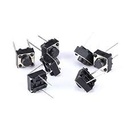Analog Grayscale sensor tracking module
This content will be shared across all product pages.
Description:
The analog grayscale sensor tracking module is a simple sensor used to detect and differentiate between various shades of gray (or sometimes colors) based on reflected light intensity. It's a popular choice for beginner robotics projects due to its ease of use and affordability.
Key Features:
- Detects and differentiates between grayscale levels (or sometimes colors)
- Typically uses a white LED for illumination and a photoresistor for light detection
- May include signal conditioning circuitry for output voltage adjustment
- Some modules have multiple sensors arranged for line tracking functionality
Technical Specifications (May Vary):
- Operating Voltage: Typically 3.3V or 5V
- Output Voltage Range: Analog voltage output corresponding to the detected grayscale level (higher voltage for lighter shades)
- Detection Range: Short range (a few centimeters)
- Sensitivity: Can be affected by ambient light conditions
Applications:
- Line Following Robots: Simple line following robots use this sensor to detect and follow a black line on a white background (or vice versa).
- Object Sorting (Simple): In basic setups, the sensor can differentiate between objects of different shades for simple sorting applications.
- Interactive Art Projects: The sensor can be used in art projects to create light or sound effects based on the perceived grayscale of a surface.
- Educational Robotics: These modules are popular choices for educational robotics kits due to their simplicity and affordability.
Datasheet:
Technical Specifications:
- Logic Family: CMOS
- Number of Channels: 3
- Switch Configuration: Single-Pole Double-Throw (SPDT)
- Supply Voltage Range: 3V to 15V
- “ON” Resistance (R_ON): 125Ω typical at V_DD = 10V
- “OFF” Leakage Current (I_OFF): ±100pA typical at V_DD = 10V
- Control Input Voltage (V_IH): 0.7 V_DD min, 0.3 V_DD max
- Maximum Operating Frequency: 40 MHz at V_DD = 10V
Applications:
- Signal routing and switching
- Analog and digital multiplexing
- Audio and video signal processing
- Data acquisition systems
- Test equipment

